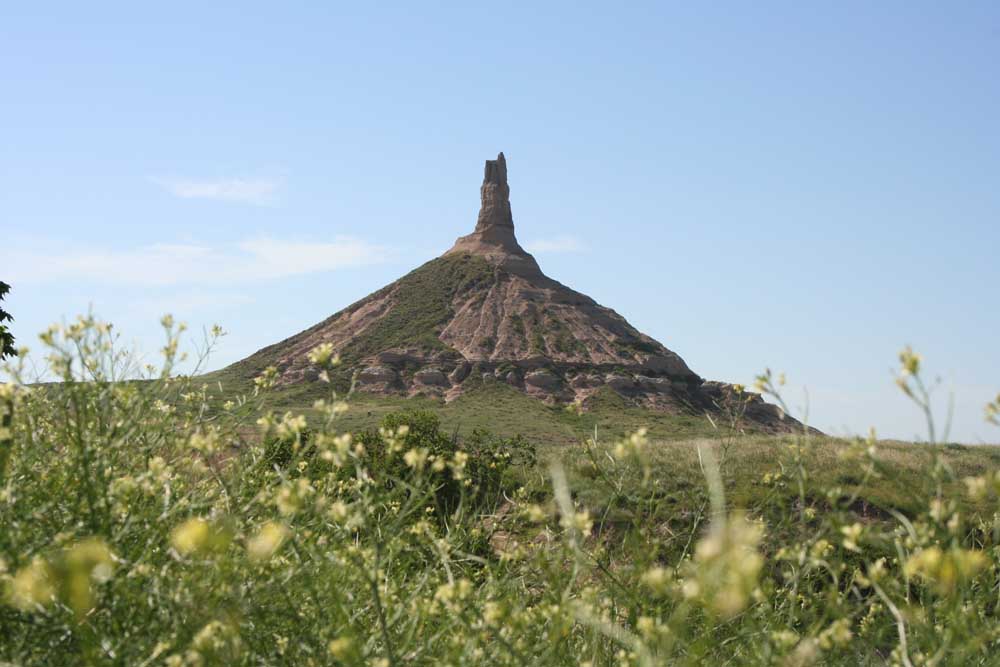Western Nebraska is a land full of surprises
Published 12:00 am Sunday, January 31, 2016

- Chimney Rock near Bayard is an excellent example of how water and wind erode the earth. Chimney Rock is also considered an important landmark on the Oregon Trail.
The buffalo isn’t happy. She is eyeing me warily from perhaps a dozen feet away, with only a rickety wooden and wire fence separating the two of us. She’s shaggy but gorgeous, this iconic symbol of the Great Plains, and as I raise my camera to snap a photo, her eyes lock with mine. Suddenly miffed by my intrusion, or maybe my red sweater, she takes a couple of steps backward, snorts mightily and then charges full speed ahead, with only the fence stopping her from chasing me down.
There is possibly nothing more highly amusing than to see a big ol’ plump blond woman run as fast as the wind blowing across the Nebraska prairie.
The tango between the bison and me is at the High Plains Homestead close to Crawford, in the far northwest corner of Nebraska near its intersection with South Dakota and Wyoming. The Homestead, reached by threading a number of well-maintained dirt roads, is reminiscent of an Old West cowboy town, reconstructed with all the trimmings of a sheriff’s office and jail, a school, a saloon with swinging doors so authentic that you expect a rootin’, tootin’ Yosemite Sam to come crashing through at any moment and the critters, a menagerie of horses, chickens and buffalo, one in particular that doesn’t care for my presence in the least.
While my traveling companions and I — there are four friends, all ladies, in our rented van — had visited only to partake of the Homestead’s delectable ribs that are slow-cooked on an outdoor grill, you can stay here for a spell, bed-and-breakfast style, in the rooms decorated to honor Nebraska’s cowboys, cowgirls and caballeros. At heart I’m a nature traveler, and always before going to a place I’ve never been before, I have preconceived notions and expectations about what the landscape will look like. Western Nebraska is like that. I expected it to be an inland ocean of flat, open prairies, endless grasslands and gently rising sand hills.
A prehistoric land
That is all here, of course, but what I didn’t expect to find is a land, an almost prehistoric land, of high plains striated by mesas, buttes and the strangest of rock formations and then cut with ribbons of silent mountains, deep valleys and fertile river beds. All of this unexpected natural beauty caught me off-guard. I can blame the journey to western Nebraska not only on nature, but also on wonderful “Lonesome Dove,” Larry McMurtry’s beloved and prize-winning novel and later CBS miniseries that depicted a cattle drive from Texas to Montana and which takes the motley crew of cowboys through Nebraska. When the cowboy character of Augustus “Gus” McCrae, played to absolute perfection by Robert Duvall, tells Diane Lane’s character of lady-of-the-evening Lorena he’s “bound for Ogallala, honey,” on the cattle drive to see “a woman named Clara,” a long-lost love, my interest was piqued. I picked up a map and found that Ogallala actually exists not only in fiction but reality, too.
And that’s how I found myself in Nebrasky in Gus-speak. For a few days this past summer, we drove hundreds of miles across the western fringes of Nebrasky, from Sidney and Ogallala in the south to Alliance, Scottsbluff and Gering in its middle, to Crawford and Fort Robinson State Park in the north.
The roads are gloriously empty, with no such thing as rush hour, unless you count the herds of deer and antelope playing in the open fields. Cue music here of “Home on the Range.”
As a rural Southerner, I live among the thickest woods of hardwood and pine. Probably because of that, I am addicted to the natural beauty of wide-open places, only in that they are something that I am not used to seeing amid the verdant forests of the South. Western Nebraska does not disappoint in that regard, and it is here that the heartland meets the wild, wild West under clouds floating like flower petals in the big bright cerulean skies.
Ogallala
On the drive to Ogallala from Sidney, where we had first overnighted, my mind conjures images of the great herds of cattle driven up from Texas as they feasted on the sweet prairie grass. Ogallala is a small town of fewer than 5,000 where its cowboy roots are still strong with plenty of cattle ranchers and farmers. In Ogallala proper, we visit the Petrified Wood Gallery with its collection of petrified wood art, then take time to climb the steps to Boot Hill, a flower-strewn cemetery that was quite literally the end of the trail for cowboys and pioneers who first settled the town where the fictional Clara lived.
The South Platte River, framed by willowy cottonwoods, meanders through Ogallala from Colorado and Wyoming eastward toward the Missouri River. Not far from Ogallala, we pass a jigsaw puzzle of low green knolls, stopping at Windlass Hill at Ash Hollow State Historical Park, notched in part by fragrant valleys smothered with wild roses, currants and chokeberries. The Oregon Trail crosses here, the deep trenches of wagon ruts of long ago still visible. Looking westward toward the Rockies and across the seemingly endless landscape, I thought how brave those early pioneers were to cross these beautiful valleys toward an uncertain future.
While the primary goal of our journey was really to bask in the beauty of Nebraska’s great outdoors, our road trip revealed a plethora of historic and natural treasures that we had never heard of until we started driving. One of those places is Chimney Rock Historic Site near Bayard. The process of erosion through wind, rain and snow has sculpted myriad natural gifts and is a humbling reminder that nature’s force is not to be reckoned with lightly.
Chimney Rock, one of those extraordinary stories of sandstone erosion, is one of the landmarks along the Oregon Trail and could have been plucked from the old ’60s movie “One Million Years B.C.” I can best describe it as an amalgamation of towering chimney, obelisk and pyramid that’s visible for miles on end. Courthouse and Jail Rocks near Bridgeport are also some of the more well-known erosion-created rock formations and resemble, well, a courthouse and jail. No shortage of roadside wonders exists in this part of Nebrasky.
The Great Plains
Moving on, our all-girl van putters across the Great Plains, which are essentially the remnants of ancient oceans that once covered this part of Nebraska. We stop at Scott’s Bluff National Monument, sometimes called Nebraska’s Rock of Gibraltar. At the visitor’s center at the base of the bluff, we learn Scott’s Bluff is yet another landmark on the Oregon Trail and was once a stop for the Pony Express. We then drive to the top of the bluff — named for Hiram Scott, a fur trader and trapper who died nearby in the early 1830s — where the untamed wind tears across the plains. But even the crazy wind couldn’t deter from the impressive 360-degree views of the tapestry of Nebraska’s primordial plains where dinosaurs and massive herds of bison once roamed.
Yet another surprise of western Nebraska is how quickly the topography changes with every turn of the road. Parts of western Nebraska, particularly in the northwestern corner near the Agate Fossil Beds, look much like the rolling desert-like hills of Tanzania’s Serengeti. Toadstool Geologic Park, also in the northwest, has all the hallmarks of a moonscape with its haunting rock formations. Parts of 22,000-acre Fort Robinson State Park, which a friend from Omaha called the jewel of her home state, is as forested as the South. Here we went on safari, Nebraska-style, taking a four-wheel drive adventure over steep, rocky dirt roads looking for, and finding, skittish big horn sheep.
With all the remoteness of our long drives, we had little or no Internet or cell service, which makes this part of Nebraska an excellent place to learn to read a real paper map, make good use of your sense of adventure, and better still just get off the grid for a while. But beware the buffalo and don’t wear red.






